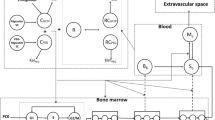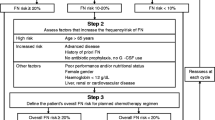Abstract
The ability to predict the incidence of chemotherapy-induced neutropenia in early drug development can inform risk monitoring and mitigation strategies, as well as decisions on advancing compounds to clinical trials. In this report, a physiological model of granulopoiesis that incorporates the drug’s mechanism of action on cell cycle proliferation of bone marrow progenitor cells was extended to include the action of the cytotoxic agents paclitaxel, carboplatin, doxorubicin, and gemcitabine. In vitro bone marrow studies were conducted with each compound, and results were used to determine the model’s drug effect parameters. Population simulations were performed to predict the absolute neutrophil count (ANC) and incidence of neutropenia for each compound, which were compared to results reported in the literature. In addition, using the single agent in vitro study results, the model was able to predict ANC time course in response to paclitaxel plus carboplatin in combination, which compared favorably to the results reported in a phase 1 clinical trial of 46 patients (r2 = 0.70). Model simulations were used to compare the relative risk (RR) of neutropenia in patients with high baseline ANCs for five chemotherapeutic regimens: doxorubicin (RR = 0.59), paclitaxel plus carboplatin combination (RR = 0.079), carboplatin (RR = 0.047), paclitaxel (RR = 0.031), and gemcitabine (RR = 0.013). Finally, the model was applied to quantify the reduced incidence of neutropenia with coadministration of pegfilgrastim or filgrastim, for both paclitaxel and the combination of paclitaxel plus carboplatin. The model provides a framework for predicting clinical neutropenia using in vitro bone marrow studies of anticancer agents that may guide drug development decisions.






Similar content being viewed by others
References
Craig M. Towards quantitative systems pharmacology models of chemotherapy-induced neutropenia. CPT: PSP. 2017;6(5):293–304.
Schirm S, Engel C, Loeffler M, Scholz M. Modelling chemotherapy effects on granulopoiesis. BMC Syst Biol. 2014;8:138.
Guo Y, Haddish-Berhane N, Xie H, Ouellet D. Optimization of clinical dosing schedule to manage neutropenia: learnings from semi-mechanistic modeling simulation approach. J Pharmacokinet Pharmacodyn. 2020;47:47–58.
Chen W, Boras B, Sung T, Yu Y, Zheng J, Wang D, et al. A physiological model of granulopoiesis to predict clinical drug induced neutropenia from in vitro bone marrow studies: with application to a cell cycle inhibitor. J Pharmacokinet Pharmacodyn. 2020;47:163–82.
Appleman LJ, Beumer JH, Jiang Y, Lin Y, Ding F, Puhalla S, et al. Phase 1 study of veliparib (ABT-888), a poly (ADP-ribose) polymerase inhibitor, with carboplatin and paclitaxel in advanced solid malignancies. Cancer Chemother Pharmacol. 2019;84(6):1289–301.
Hu W, Sung T, Jessen BA, Thibault S, Finkelstein MB, Khan NK, et al. Mechanistic investigation of bone marrow suppression associated with palbociclib and its differentiation from cytotoxic chemotherapies. Clin Cancer Res. 2016;22(8):2000–8.
Leung L, Yang X, Strelevitz TJ, Montgomery J, Brown MF, Zientek MA, et al. Clearance prediction of targeted covalent inhibitors by in vitro-in vivo extrapolation of hepatic and extrahepatic clearance mechanisms. Drug Metab Dispos. 2017;45(1):1–7.
National Cancer Institute. Common terminology criteria for adverse events, version 4.0. 2009. 2016.
Pazdur R, Kudelka AP, Kavanagh JJ, Cohen PR, Raber MN. The taxoids: paclitaxel (Taxol®) and docetaxel (Taxotere®). Cancer Treat Rev. 1993;19(4):351–86.
D’Argenio DZ, Schumitzky A, Wang X. ADAPT 5 user’s guide: pharmacokinetic/pharmacodynamic systems analysis software. Los Angeles: Biomedical Simulations Resource; 2009.
Go RS, Adjei AA. Review of the comparative pharmacology and clinical activity of cisplatin and carboplatin. J Clin Oncol. 1999;17(1):409–22.
Knox RJ, Friedlos F, Lydall DA, Roberts JJ. Mechanism of cytotoxicity of anticancer platinum drugs: evidence that cis-diamminedichloroplatinum(ii) and cis-diammine-(l,l-cyclobutanedicarboxylato)platinum(ii) differ only in the kinetics of their interaction with DNA. Cancer Res. 1986;46(4 Pt 2):1972–9.
Wang Y, Probin V, Zhou D. Cancer therapy-induced residual bone marrow injury: mechanisms of induction and implication for therapy. Curr Cancer Therapy Rev. 2006;2(3):271–9.
Woo S, Krzyzanski W, Jusko WJ. Pharmacodynamic model for chemotherapy-induced anemia in rats. Cancer Chemother Pharmacol. 2008;62(1):123–33.
Fornari C, O’Connor LO, Pin C, Smith A, Yates JWT, Amy Cheung SY, et al. Quantifying drug-induced bone marrow toxicity using a novel haematopoiesis systems pharmacology model. CPT Pharmacometrics Syst Pharmacol. 2019;8(11):858–68.
Plunkett W, Huang P, Xu YZ, Heinemann V, Grunewald R, Gandhi V. Gemcitabine: metabolism, mechanisms of action, and self-potentiation. Seminars in Oncology. 1995;22(4 Supple 11):3–10.
Tacar O, Sriamornsak P, Dass CR. Doxorubicin: an update on anticancer molecular action, toxicity and novel drug delivery systems. J Pharm Pharmacol. 2013;65(2):157–70.
Cutts SM, Nudelman A, Rephaeli A, Phillips DR. The power and potential of doxorubicin-DNA adducts. IUBMB Life. 2005;57(2):73–81.
Swift LP, Rephaeli A, Nudelman A, Phillips DR, Cutts SM. Doxorubicin-DNA adducts induce a non-topoisomerase II-mediated form of cell death. Cancer Res. 2006;66(9):4863–71.
Cutts S, Rephaeli A, Nudelman A, Ugarenko M, Phillips D. Potential therapeutic advantages of doxorubicin when activated by formaldehyde to function as a DNA adduct-forming agent. Curr Top Med Chem. 2015;15(14):1409–22.
Dobson JM, Hohenhaus AE, Peaston AE. Cancer chemotherapy. In: Maddison JE, Page SW, Church DB, editors. Small Animal Clinical Pharmacology. 2nd ed. Elsevier; 2008. p. 330–366.
Henningsson A, Karlsson MO, Viganò L, Gianni L, Verweij J, Sparreboom A. Mechanism-based pharmacokinetic model for paclitaxel. J Clin Oncol. 2001;19(20):4065–73.
Zandvliet AS, Schellens JHM, Dittrich C, Wanders J, Beijnen JH, Huitema ADR. Population pharmacokinetic and pharmacodynamic analysis to support treatment optimization of combination chemotherapy with indisulam and carboplatin. Br J Clin Pharmacol. 2008;66(4):485–97.
Sugiyama E, Kaniwa N, Kim SR, Hasegawa R, Saito Y, Ueno H, et al. Population pharmacokinetics of gemcitabine and its metabolite in Japanese cancer patients: impact of genetic polymorphisms. Clin Pharmacokinet. 2010;49(8):549–58.
Thompson PA, Rosner GL, Matthay KK, Moore TB, Bomgaars LR, Ellis KJ, et al. Impact of body composition on pharmacokinetics of doxorubicin in children: a Glaser Pediatric Research Network study. Cancer Chemother Pharmacol. 2009;64:243–51.
Herrmann R, Bodoky G, Ruhstaller T, Glimelius B, Bajetta E, Schüller J, et al. Gemcitabine plus capecitabine compared with gemcitabine alone in advanced pancreatic cancer: a randomized, multicenter, phase III trial of the Swiss Group for Clinical Cancer Research and the Central European Cooperative Oncology Group. J Clin Oncol. 2007;25(16):2212–7.
Cunningham D, Chau I, Stocken DD, Valle JW, Smith D, Steward W, et al. Phase III randomized comparison of gemcitabine versus gemcitabine plus capecitabine in patients with advanced pancreatic cancer. J Clin Oncol. 2009;27(33):5513–8.
Poplin E, Feng Y, Berlin J, Rothenberg ML, Hochster H, Mitchell E, et al. Phase III, randomized study of gemcitabine and oxaliplatin versus gemcitabine (fixed-dose rate infusion) compared with gemcitabine (30-minute infusion) in patients with pancreatic carcinoma E6201: a trial of the Eastern Cooperative Oncology Group. J Clin Oncol. 2009;27(23):3778–85.
Van Cutsem E, van de Velde H, Karasek P, Oettle H, Vervenne WL, Szawlowski A, et al. Phase III trial of gemcitabine plus tipifarnib compared with gemcitabine plus placebo in advanced pancreatic cancer. J Clin Oncol. 2004;22(8):1430–8.
Kindler HL, Niedzwiecki D, Hollis D, Sutherland S, Schrag D, Hurwitz H, et al. Gemcitabine plus bevacizumab compared with gemcitabine plus placebo in patients with advanced pancreatic cancer: phase III trial of the Cancer and Leukemia Group B (CALGB 80303). J Clin Oncol. 2010;28(22):3617–22.
Okusaka T, Nakachi K, Fukutomi A, Mizuno N, Ohkawa S, Funakoshi A, et al. Gemcitabine alone or in combination with cisplatin in patients with biliary tract cancer: a comparative multicentre study in Japan. Br J Cancer. 2010;103(4):469–74.
Friberg LE, Henningsson A, Maas H, Nguyen L, Karlsson MO. Model of chemotherapy-induced myelosuppression with parameter consistency across drugs. J Clin Oncol. 2002;20:4713–21.
Joerger M, Huitema ADR, Richel DJ, Dittrich C, Pavlidis N, Briasoulis E, et al. Population pharmacokinetics and pharmacodynamics of paclitaxel and carboplatin in ovarian cancer patients: a study by the European organization for research and treatment of cancer-pharmacology and molecular mechanisms group and new drug development group. Clin Cancer Res. 2007;13(21):6410–8.
Aapro MS, Bohlius J, Cameron DA, Lago LD, Donnelly JP, Kearney N, et al. 2010 update of EORTC guidelines for the use of granulocyte-colony stimulating factor to reduce the incidence of chemotherapy-induced febrile neutropenia in adult patients with lymphoproliferative disorders and solid tumours. Eur J Cancer. 2011;47(1):8–32.
Aronson JK, editor. Meyler’s side effects of drugs: the international encyclopedia of adverse drug reactions and interactions. In: Choice Reviews Online [Internet]. 16th ed. 2016. p. 445–52. Available from: http://www.sciencedirect.com/science/article/pii/B9780444537171012130. Accessed 18 June 2020.
Gemcitabine - DrugBank [Internet]. Available from: http://www.drugbank.ca/drugs/DB00441. Accessed 18 June 2020.
Carboplatin dosing, indications, interactions, adverse effects, and more [Internet]. Available from:http://reference.medscape.com/drug/paraplatin-carboplatin-342107. Accessed 18 June 2020.
Doxorubicin - DrugBank [Internet]. Available from: http://www.drugbank.ca/drugs/DB00997. Accessed 18 June 2020.
Gemzar - Drug information - Chemocare [Internet]. Available from: http://chemocare.com/chemotherapy/drug-info/gemzar.aspx. Accessed 8 Dec 2019.
Drug name: doxorubicin - BC Cancer [Internet]. Available from:http://www.bccancer.bc.ca/drug-database-site/DrugIndex/Doxorubicin_monograph.pdf. Accessed 8 Dec 2019.
Bronchud MH, Howell A, Crowther D, Hopwood P, Souza L, Dexter TM. The use of granulocyte colony-stimulating factor to increase the intensity of treatment with doxorubicin in patients with advanced breast and ovarian cancer. Br J Cancer. 1989;60:121–5.
Du Bois A, Luck H-J, Meier W, Adams H-P, Mobus V, Costa S, et al. A randomized clinical trial of cisplatin/paclitaxel versus carboplatin/paclitaxel as first-line treatment of ovarian cancer. J Natl Cancer Inst. 2003;95(17):1320–9.
Karlsson MO, Molnar V, Freijs A, Nygren P, Bergh J, Larsson R. Pharmacokinetic models for the saturable distribution of paclitaxel. Drug Metab Dispos. 1999;27(10):1220–3.
Ait-Oudhia S, Mager DE, Straubinger RM. Application of pharmacokinetic and pharmacodynamic analysis to the development of liposomal formulations for oncology. Pharmaceutics. 2014;6(1):137–74.
Roskos LK, Lum P, Lockbaum P, Schwab G, Yang BB. Pharmacokinetic/pharmacodynamic modeling of pegfilgrastim in healthy subjects. J Clin Pharmacol. 2006;46:747–57.
Krzyzanski W, Wiczling P, Lowe P, Pigeolet E, Fink M, Berghout A, et al. Population modeling of filgrastim PK-PD in healthy adults following intravenous and subcutaneous administrations. J Clin Pharmacol. 2010;50:101S–12S.
Pastor ML, Laffont CM, Gladieff L, Schmitt A, Chatelut E, Concordet D. Model-based approach to describe g-csf effects in carboplatin-treated cancer patients. Pharm Res. 2013;30(11):2795–807.
Acknowledgments
We gratefully acknowledge Dr. Jan H. Beumer of the Cancer Therapeutics Program, and the Departments of Pharmaceutical Sciences and Medicine at the University of Pittsburgh for providing the paclitaxel/carboplatin clinical trial data. The work was presented originally at the American Conference on Pharmacometrics in 2019, Orlando, FL.
Funding
This work was supported by grants from National Institutes of Health/National Institute of Biomedical Imaging and Bioengineering (NIH/NIBIB) P41-EB001978 and the Alfred E. Mann Institute at USC (DZD).
Author information
Authors and Affiliations
Corresponding author
Ethics declarations
Conflict of Interest
W. Chen and D.Z. D’Argenio declare no conflict of interests. B. Boras, T. Sung, W. Hu, and M.E. Spilker are employees of Pfizer, Inc. These authors have no other relevant affiliations or financial involvement with any organization or entity with a financial interest in or financial conflict with the subject matter or materials discussed in the manuscript apart from those disclosed.
Additional information
Publisher’s Note
Springer Nature remains neutral with regard to jurisdictional claims in published maps and institutional affiliations.
Supplementary Information
ESM 1
(PDF 214 kb)
Rights and permissions
About this article
Cite this article
Chen, W., Boras, B., Sung, T. et al. Predicting Chemotherapy-Induced Neutropenia and Granulocyte Colony–Stimulating Factor Response Using Model-Based In Vitro to Clinical Translation. AAPS J 22, 143 (2020). https://doi.org/10.1208/s12248-020-00529-x
Received:
Accepted:
Published:
DOI: https://doi.org/10.1208/s12248-020-00529-x




